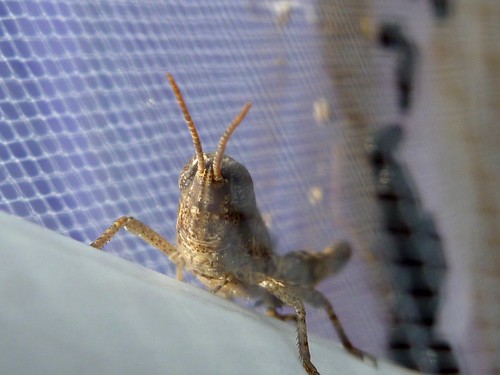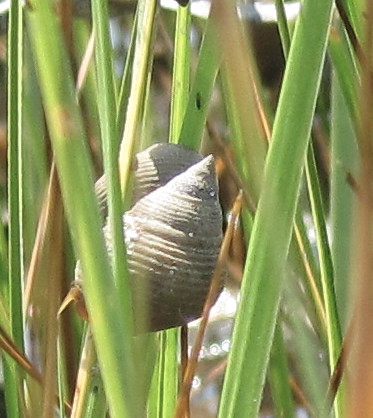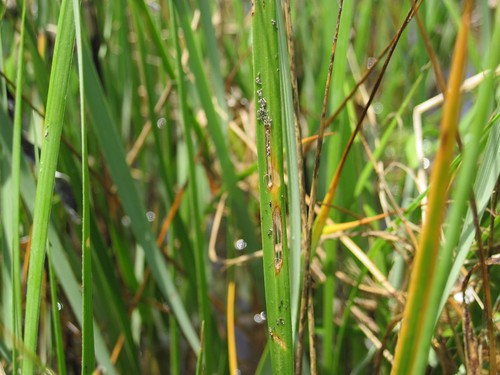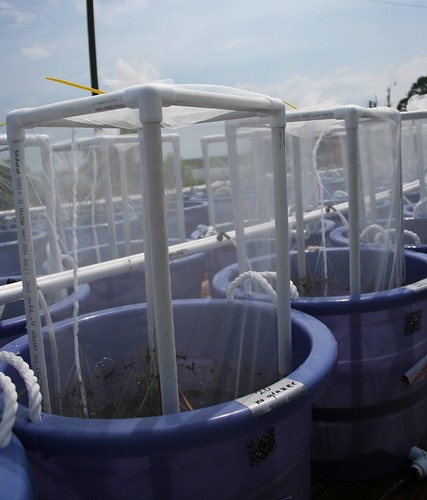Dr. Randall Hughes FSU Coastal & Marine Lab
 One of the really interesting aspects of the marsh community is that it is a mix of sea-based and land-based critters. At low tide, insects and rodents move in, whereas at high tide, snails, fish, and crabs dominate. The 2 most common plant grazers at our sites illustrate this dichotomy :
One of the really interesting aspects of the marsh community is that it is a mix of sea-based and land-based critters. At low tide, insects and rodents move in, whereas at high tide, snails, fish, and crabs dominate. The 2 most common plant grazers at our sites illustrate this dichotomy :
one is a land-based grasshopper(Dicromorpha elegans),
and the other is a sea-based snail (Littoraria irrorata).
In addition to being very abundant in our sites, the grasshoppers and snails leave distinctive grazing marks that alert us to their activity. Grasshoppers tend to chew large pieces out of the margin of the leaves, often resulting in the removal of large portions of the upper leaves. Snails, on the other hand, create razor-blade like incisions in the middle of the leaf:
We are interested in the potential for interactions between these 2 consumers, because they occur together in abundance at several of our sites. A preliminary experiment last summer suggested that snails somehow deter grasshopper feeding, even though neither animal can directly harm the other. (In fact, as you can see from the video, sometimes the grasshoppers even hang out on the snails’ backs!) However, it is possible that snails leave a “slime” trail that the grasshoppers don’t like, or perhaps snail grazing causes the plants to produce chemicals that make it less likely that grasshoppers will eat them.
To find out more, we are repeating the same experiment (with some minor modifications) to look more closely at how much snails and grasshoppers eat when they are alone versus how much they eat when they are together. Because it is difficult to make grasshoppers stay where you want them, we are doing the experiment in mesh cages inside “mesocosms” (science-speak for large buckets) at the FSU Coastal and Marine Lab.
The mesocosms are set up to mimic the natural tidal cycle, with both high and low tides on a regular basis. We measured the height and number of stems of all the plants in each mesocosm at the start of the experiment, and we’ll take these same data at the end of a couple of weeks to see which species has the largest effect, and whether their combined effects are different from what we expect based on what they eat alone.
As an aside, this experiment is a good example of one of my ecologist’s rules of thumb: you can never do an experiment just once. There are certainly exceptions to this rule. (For example, when you have lots of experience with the animals you are experimenting with, when the experiment is just too large to repeat, or when the experiment relies on something you can’t manipulate, such as an oil spill.) However, I find that it generally takes one go-around to work out the kinks, figure out the relevant time frame, and discover unanticipated results. Then I can be much more confident the second time around that the patterns I am seeing are real!
The music in the piece was by Ric Edmiston. We are always looking for local musicians to score our videos. If you are interested and already have some music recorded, we would love your submission.
Randall’s research is funded by the National Science Foundation.






5 comments
There is a lot of work involved to set up a research project!
[…] the grass, periwinkle snails have climbed up the cordgrass to escape conchs and blue crabs. They and the grasshoppers eat the cordgrass. The cordgrass gets essential oxygen from the fiddler crab burrows and shelters the fish and […]
[…] Who can eat more- Grasshoppers or snails? […]
[…] at nearby institutions. For instance, this year I went to talks on grasshopper grazing in Juncus (a subject near and dear to my heart) and on how snails regulate their temperature in the marsh to avoid overheating. And of course, […]
[…] We’ll do additional tank experiments to understand the single and combined effects of snails and grasshoppers on each other and the […]
Comments are closed.